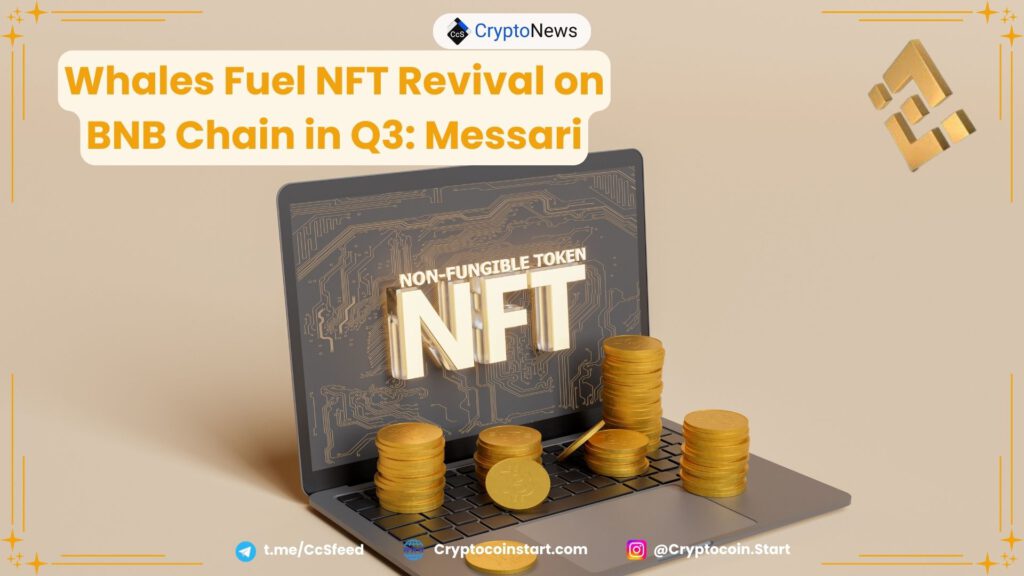
Quarterly Growth in NFT Trading Activity
Messari’s data also revealed a significant increase in the number of daily NFT sales on BNB Chain. Average daily sales rose by 47% compared to the previous quarter, reaching 8,900 transactions. However, the average daily number of buyers saw a 53% decline, dropping to just 2,300 buyers. This trend suggests that the surge in NFT activity in Q3 was primarily driven by “whales”—large investors—rather than smaller retail buyers.
BNB Chain’s NFT Trading Volume in Comparison
Despite this surge, BNB Chain’s NFT trading volume of $55.2 million in Q3 still lags behind other major blockchain networks. In comparison, Ethereum generated $120.7 million, Bitcoin saw $74.6 million, and other blockchains like Solana, Mythos Chain, Polygon, and Immutable experienced higher trading volumes than BNB Chain during the same period, according to CryptoSlam data.
Other Key Performance Metrics for BNB Chain
While BNB Chain has seen growth in some areas, other performance metrics showed mixed results in Q3 2024.
- Revenue Decline: BNB Chain’s revenue fell by 27.9% quarter-on-quarter to $34.9 million, primarily due to a 27% drop in gas fees paid for decentralized finance (DeFi) transactions.
- Active Addresses and Transactions: The number of daily active addresses dropped by 19%, falling to 900,000. Additionally, the average daily transactions decreased by 8.1%.
- Total Value Locked (TVL): The TVL on BNB Chain saw a slight increase of 2.2%, reaching $4.8 billion by the end of Q3. The Venus Finance protocol, an algorithmic money market, was the biggest contributor, increasing by 13% to $1.79 billion.
- Deflationary Effects: The network experienced a deflationary effect in Q3, as more BNB tokens were burned than minted. This resulted in a 4.5% deflation rate, contributing to a 2.5% price increase for BNB, even as the broader market showed slight regression.
Common Use Cases for BNB Chain
According to Messari’s analysis, the most common use cases for BNB Chain continue to revolve around the Tether (USDT) stablecoin and the decentralized exchange PancakeSwap. These platforms are integral to the BNB ecosystem, driving significant transaction volume and user engagement.
BNB Chain’s Position in the Blockchain Ecosystem
Launched by the cryptocurrency exchange Binance in 2020 under the name Binance Smart Chain (BSC), BNB Chain remains one of the largest blockchain networks by Total Value Locked (TVL). It currently holds the fourth position among layer-1 blockchains, behind Ethereum, Solana, and Tron, according to data from DefiLlama.
New Developments: Real-World Asset Tokenization
In addition to its growth in the NFT space, BNB Chain has introduced a new real-world asset (RWA) tokenization service. This innovative service allows individuals and businesses to tokenize real-world assets in a matter of minutes, with no coding required. Binance team members behind the solution claim it significantly reduces the cost, time, and effort required to tokenize assets, making it more accessible to a broader range of users.
Conclusion
Overall, BNB Chain has demonstrated resilience and growth in several key areas, including NFT trading volumes, Total Value Locked, and the introduction of new features like RWA tokenization. While the platform faces challenges in maintaining active user engagement and revenue, it continues to position itself as a major player in the blockchain ecosystem, particularly in the decentralized finance and NFT markets.

